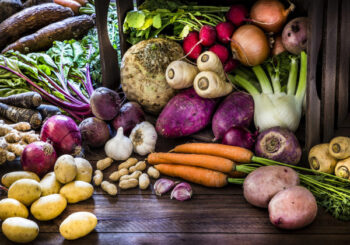Guest Writers for Wake Up World
When we think of foods synonymous with detoxification, images of leafy greens and chlorella usually come to mind. We don’t usually think of root vegetables, but maybe we should! As it turns out, roots and tubers are treasure troves of good health and can be used this time of year for your cool-weather detoxification routine.
What Makes Roots and Tubers Unique?
First, a little clarification may be in order. If you have ever wondered what the difference is between a root and a tuber, here is your answer:
Although many people continue to use the terms interchangeably, there is actually a difference. While they both grow underground, roots, or rhizomes, are specifically designed to not only store nutrients and water, but to also draw these necessary ingredients up into the plant’s stalk, stems and leaves. A tuber, on the other hand, is mostly a “storage bin” for nutrients since they lack the mechanisms through which to draw nutrients to above-ground parts. Examples of roots are carrots, radishes, and turmeric. Sweet potatoes and taro, on the other hand, are classified as tubers.
What roots and tubers have in common is a plethora of concentrated nutrients that human beings have used for their good health – and, indeed, for their very survival – for the last 100,000 years. This, of course, includes substances that can have detoxification benefits for the liver, the kidneys, the gut, the brain, the skin, the blood, and the respiratory tract as well as particular phytonutrients which are geared towards removing, eliminating, and protecting against both externally and internally produced toxics.
The Super 7 Detox Roots and Tubers
So let’s dive right in and learn about 7 roots and tubers and what they can do for your detoxification goals. Some of them may be new to you. Others may be very familiar, although you may be surprised about just how much benefit they can give to you for detoxification. Odds are, after reading this article, you will never look at those lowly sweet potatoes or turnips in your pantry quite the same way again!
Root Herbs
1 | Ginseng
Pretty much everybody has heard of this “king of the herbs,” and you probably have too. Its history as a medicinal root goes back centuries. While ginseng is a unique-looking root that can grow quite large and sometimes take odd shapes, ginseng also grows all over the world. There are varieties which hail from Indian and surrounding Asian nations as well as Latin American countries such as Peru.
Ginseng is full of phytonutrients that act as antioxidants that can help the cardiovascular system and encourage healthy blood flow. The phytonutrient that makes ginseng such a healing powerhouse, however, is a saponin called ginsenoside.
A big benefit of ginsenoside is how it can support the liver. A 2012 Japanese study published in the academic journal, Evidence-Based Complementary and Alternative-Based Medicine, found that “ginseng extracts and individual ginsenosides have shown a wide array of beneficial role[s] in the regulation of regular liver functions and the treatment of liver disorders of acute/chronic hepatotoxicity, hepatitis, hepatic fibrosis/cirrhosis, [and] hepatocellular carcinoma.”
Ginseng can also have a detoxifying effect on the brain and is said to be neuroprotective. It can help ward off cognition-related ailments such as Parkinson’s, Alzheimer’s, and depression. Studies have long connected these conditions to toxic build-up in the brain. For example, the presence of “amyloid plaque” (the build-up of certain kinds of proteins) is one of the most common indications of Alzheimer’s Disease. In 2013, Korean researchers found that administering fermented Panax ginseng to mice who had amyloid plaque led to a significant reduction in this build-up in the brain after just 2 weeks.
2 | Andrographis
While ginseng is said to be the “king of the herbs,” Andrographis is often called the “king of the bitters.” This means that it is a powerful tonic for the liver. As a rule, bitter-tasting herbs and foods are often associated with liver healing in both Ayurvedic and Chinese medicinal traditions.
Best-selling author and natural health advocate Dr. Josh Axe has been one of the most vocal proponents of andrographis and bitter herbs, in general, for health.
“When you consume bitter foods, it releases bile, helping you better digest fat,” explained Dr. Axe in a keynote presentation for 2019 The Truth About Cancer Live event.
Amongst the many investigations verifying andrographis’ benefits for detoxification pathways was a 2008 report published in the journal Environmental Toxicology and Pharmacology. Researchers at Vidyasagar University in West Bengal, India, found that an aqueous tincture of Andrographis paniculata Nees had a detoxification effect on the liver, kidney, heart, lungs, and spleen during episodes of “nicotine induced oxidative stress” in an in vivo study.
Besides its detoxifying properties, andrographis is known mostly as a strong anti-inflammatory, anti-viral, and overall immune system booster.
“If you want to strengthen your system to really kill off a virus or a parasite or overcome cold and flu, andrographis is amazing,” Dr. Axe said.
3 | Muskroot
Muskroot is another little-known herb, also from East Asia, that is gaining headway in the West. You may have heard of muskroot by its many other names: spikenard, nardostachys jatamansi, or simply “nard.”
Muskroot has actually been found to be very protective for brain pathways and beneficial for the reduction in symptoms relating to depression, general stress, and common forms of cognitive disease. In addition, very recent research has discovered that it can be helpful for the emotional swings which often occur just prior to a woman’s monthly menstruation.
According to the Mayo Clinic, 3 out of 4 women in the United States experience some form of “pre-menstrual syndrome (PMS)” including mood swings. A 2018 study published in the Journal of Herbal Medicine took a look at how the neuroprotectant properties of spikenard affected women with strong PMS symptoms. After two months of using N. jatamansi, the women displayed “statistically significant” improvement in most symptoms of PMS, including those related to emotional ups and downs.
4 | Burdock Root
Burdock root, also known as Arctium lappa, beggar’s buttons, thorny burr, or Happy Major, is unique amongst root-based detoxifiers since it can also help extract toxins from the blood. Unlike many other detoxifying roots, burdock can actually be eaten raw or cooked. It is not bitter but has a slightly sweet flavor that makes it a good addition to soups and stews. In the United States, it is easy to find wild burdock since it often grows like a weed.
That being said, burdock looks similar to another very poisonous wild plant, namely belladonna or deadly nightshade, so great care should be taken when extracting burdock root from the wild. In addition, pregnant women should not consume burdock root, nor should those who are experiencing dehydration (burdock can act as a diuretic).
So what are the “secret ingredients” that make burdock so good for the blood? They are specifically key phytonutrients which have chelation properties, i.e., they have the ability to remove heavy metals from circulatory system pathways.
Cadmium exposure, for example, has increased in recent years and has been linked to oxidative stress, DNA damage, and increased risk of cancer, according to the U.S. National Institutes of Health. In a 2017 study, a 200 mg administration of Arctium lappa for five weeks significantly helped kidney function that was impaired by cadmium overexposure in a rat model. Benefits of burdock root for liver damage induced by lead toxicity were discovered in similar 2019 studies as well.
Burdock’s benefits for blood circulation can significantly improve other functions in the body, as well. A 2008 German study found that burdock helped improve the visible signs of aging since it can help draw blood up to the surface for better toxic drainage and blood circulation in skin cells. In addition, studies have found that burdock can help lymphatic system flow and drainage.
Common Roots and Tubers
5 | Turnips
Yes, turnips! This cousin to the Brussel sprout (it is also in the same family as broccoli, arugula, and kale) is not technically a root or tuber, although its form and the way it grows lead many people to identify it as such.
All parts of the turnip contain detoxifying agents. The long green tops are chock full of phytonutrients called glucosinolates, which have been shown to boost both Phase 1 and Phase 2 detoxification. Turnip greens are also rich in many nutrients, including vitamin A, vitamin K, vitamin C, copper, folate, manganese, and fiber.
Remember, we mentioned that turnips were actually part of the same vegetable family as broccoli? That means that it is a cruciferous vegetable. All cruciferous veggies contain the phytonutrient powerhouse known as sulforaphane. Besides being a cancer-fighter (it has the ability to target cancer stem cells), sulforaphane also increases the production of certain enzymes, which help to eliminate toxins and boost liver function.
6 | Radishes
Radishes come in all kinds of shapes, sizes, and colors; there is at least one variety of radish that grows in every season of the year. Likewise, all radishes can be beneficial for your health, albeit in slightly different ways. Radish contains many nutritious minerals and vitamins, especially potassium, selenium, and natural sulfur compounds. Because of these nutrients and others, radish can be extremely cleansing for the digestive system and major detoxification pathways.
Some types of radish, however, have a deeper cleansing effect. Black radish has been used since antiquity for cleansing the blood, including help for jaundice, because certain substances within it have a purging effect against bilirubin. Bilirubin is the “waste” created in the breakdown of red blood cells.
Interestingly, a 2018 report published in the Journal of Food Medicine discovered that a substance called erucamide, which exists in the leaves of common red radishes (Raphanus sativus L.), may be neuroprotective against Alzheimer’s as well.
7 | Sweet Potatoes
Sweet potatoes are common tubers that you probably don’t think twice about once you get them from your grocery bag to your kitchen cupboard. It may come as a surprise, then, that many health experts classify them as a “superfood.”
What’s more, the majority of the protein in these tubers comes in the form of a substance called sporamin. Researchers have been connecting this substance to anti-cancer activities since the 1930s. Recent studies have determined how this protein substance is able to survive digestion and enter into the bloodstream. They have also affirmed a correlation between sporamin in sweet potatoes and a reduction in cancer activity for leukemia, cervical cancer, and tongue cancer.
All this good stuff means that sweet potatoes can also be cleansing in many ways, especially for the digestive system and the brain. Purple sweet potatoes, in particular, are super high in flavonoids called anthocyanins, and this has a direct correlation to their status as a neuroprotectant and possibly as a detoxifier and support for the liver as well.
What About “Tried and True” Healing Roots Like Garlic, Turmeric, and Ginger?
The purpose of this article is to introduce you to some little-known or often-overlooked roots and tubers in order to give them the credit they are due as legitimate healthy substances. So please give a big round of applause for the seven amazing roots and tubers listed above!
However, these represent just the tip of the iceberg when it comes to all the earth-bound roots and tubers out there that contain the same or similar properties. Of course, how can we forget about those tried-and-true detoxifying roots such as turmeric root, ginger root, and the mighty beet? A quick check on any of these three root veggies will produce literally thousands of studies confirming the dozens of health benefits associated with them.
Other super-healing roots and tubers include carrots, dandelion, taro, astragalus, marshmallow, Mugwort, skullcap, and Jerusalem artichoke, just to name a few.
What’s the Best Way to Consume Roots and Tubers for Health?
All of the above can come in supplement form, and many, such as burdock or ginseng, can be made into a tea.
Another way to consume healthy roots and tubers is to simply add them to the whole food dishes that you may already be making. Radishes are great chopped up in salads. Both turnip and radish tops can be added to a smoothie or juiced on their own. Turnip bulbs, sweet potatoes, and even burdock root can be added in chunks to soups, stews, and casseroles or as compliments to oven-baked organic meat dishes. Simply surround the meat with the cut veggies in the pot or pan your meat is baking in or roast them on their own for a hearty vegetarian meal.
Another advantage to cooking with any of the roots and tubers mentioned above is that they often have less of an overall carb load than regular potatoes. Sweet potatoes, for example, contain as many carbohydrates as regular potatoes. Because they have more fiber, however, their glycemic load is less. Turnips, on the other hand, contain more sugar than sweet potatoes, but they have significantly fewer calories.
Don’t Forget the Roots and Tubers
The main takeaway from all this is to not underestimate the power of certain roots and tubers for your health. Each one really is a little condensed package of nutrients and is full of detoxifying phytonutrients as well.
Just like most of the really good things in life, satisfaction (in this case, health satisfaction) often comes in the humblest of packages. Just be sure to work with a professional in the fields of functional medicine, herbal medicine, and/or homeopathy when determining what roots and tubers will work best for you and your unique needs if you are healing from any condition. Utilizing the guidance of a natural health professional really is the very best way to get the most out of any detoxification modality you may employ.
Originally published at The Truth About Cancer and reproduced here with permission.
About the author:
 Ty Bollinger is a health freedom advocate, cancer researcher, former competitive bodybuilder and author. After losing several family members to cancer, he refused to accept the notion that chemotherapy, radiation, and surgery were the most effective treatments available for cancer patients. He began a quest to learn all he possibly could about alternative cancer treatments and the medical industry. What he uncovered was shocking. There is ample evidence to support the allegation that the “war on cancer” is largely a fraud and that multinational pharmaceutical companies are “running the show.” Ty has now made it his life mission to share the most remarkable discovery he made on his quest: the vast majority of all diseases, including cancer, can be easily prevented and even cured without drugs or surgery.
Ty Bollinger is a health freedom advocate, cancer researcher, former competitive bodybuilder and author. After losing several family members to cancer, he refused to accept the notion that chemotherapy, radiation, and surgery were the most effective treatments available for cancer patients. He began a quest to learn all he possibly could about alternative cancer treatments and the medical industry. What he uncovered was shocking. There is ample evidence to support the allegation that the “war on cancer” is largely a fraud and that multinational pharmaceutical companies are “running the show.” Ty has now made it his life mission to share the most remarkable discovery he made on his quest: the vast majority of all diseases, including cancer, can be easily prevented and even cured without drugs or surgery.
For more information, visit:

If you've ever found value in our articles, we'd greatly appreciate your support by purchasing Mindful Meditation Techniques for Kids - A Practical Guide for Adults to Empower Kids with the Gift of Inner Peace and Resilience for Life.
In the spirit of mindfulness, we encourage you to choose the paperback version. Delve into its pages away from screen glare and notifications, allowing yourself to fully immerse in the transformative practices within. The physical book enriches the learning process and serves as a tangible commitment to mindfulness, easily shared among family and friends.
Over the past few years, Wake Up World has faced significant online censorship, impacting our financial ability to stay online. Instead of soliciting donations, we're exploring win-win solutions with our readers to remain financially viable. Moving into book publishing, we hope to secure ongoing funds to continue our mission. With over 8,500 articles published in the past 13 years, we are committed to keeping our content free and accessible to everyone, without resorting to a paywall.








